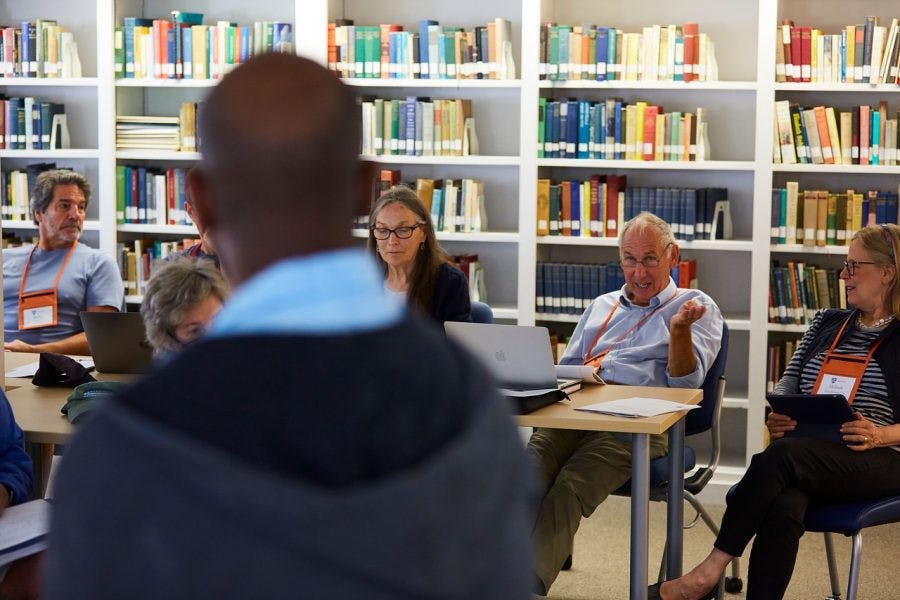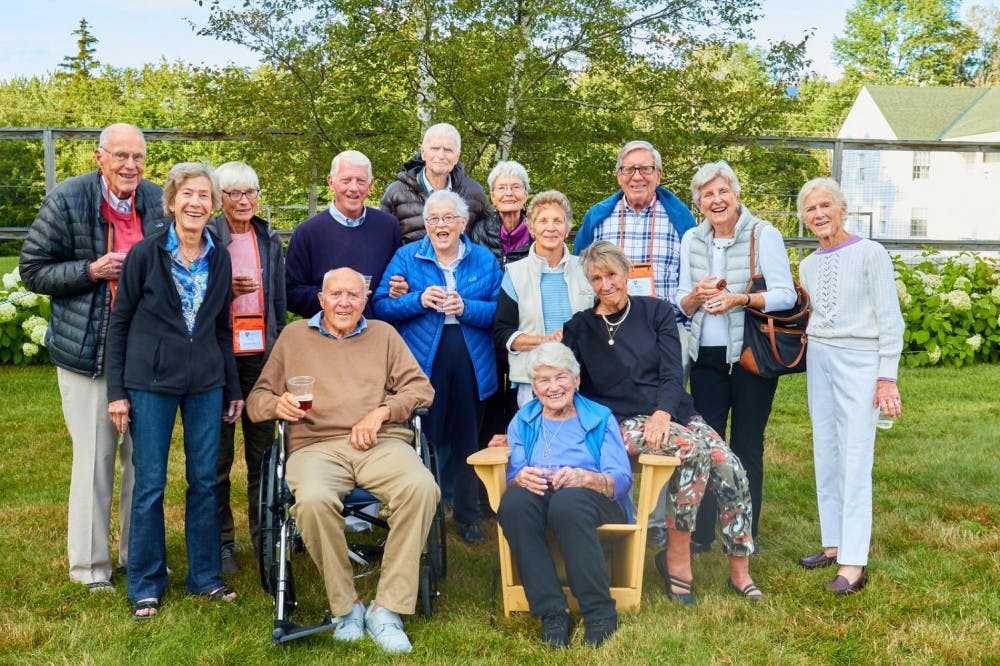Drive down scenic Route 125 and you’ll find, situated across from the Robert Frost Interpretive Trail, Middlebury College’s Breadloaf Campus in Ripton, Vt.: home to the Breadloaf School of English graduate programs during the summer as well as various MiddView groups during first-year orientation week. What’s lesser known, however, is that for 44 consecutive years, Breadloaf has welcomed back hundreds of alumni, their friends and spouses, and parents of students for an annual four-day program called Alumni College.
From Aug. 29 to Sept. 1 this year, 139 alumni came to Breadloaf to reconnect with friends, soak in the Vermont scenery and explore one of the weekend’s five course offerings. Most hailed from the New England area, but many others traveled from California, Texas and the UK to participate in the program.
According to Associate Director of Alumni and Parent Programws Lori Mackey, classes filled within the first few weeks that registration was open.
Professor of Psychology Matthew Kimble taught a course on happiness at Alumni College in 2001, and has since 2013 overseen the program’s course programming as its faculty director.
Courses for Alumni College are typically decided upon in February. Generally, Kimble looks for a program of five courses that span the humanities, social sciences and physical sciences. One Alumni College tradition is that there is almost always a field class offered, so that students have the opportunity to take full advantage of Alumni College’s pastoral setting in Ripton.
Kimble said that one of the major attractions of Alumni College is its location at the Breadloaf campus. “I don’t know what percentage of people we would lose if we were like, ‘Oh, we’re going to have classes in BiHall this year,’ but I’m feeling it would be a lot,” Kimble said. “I think people would be very disappointed. There’s something special about being up [at Breadloaf] at that time of year; it’s so beautiful.”
Despite being relatively unknown among current students, news of Alumni College travels fast through word of mouth among alumni friend groups, and the program welcomed its largest group in its 44-year history this year.
Often, classes and friends will come back regularly, using Alumni College as a reunion. “Some of [the participants] are real regulars,” Kimble said. Participants this year ranged from individuals in the class of 1951 to those in the class of 2007. Of the participants, the Class of ’55 has been known for attending Alumni College together as annual mini-reunions. They will be celebrating their 65th reunion in June of 2020.
[pullquote speaker="Bruce Byers '55" photo="" align="left" background="on" border="all" shadow="on"]Breakfast, lunch and dinner. You can’t overestimate how important it is for our group to be sitting together, three times a day.[/pullquote]
Sue Byers ’55 and Bruce Byers ’55 have been attending Alumni College for 18 years. “We became kind of famous, the class of ‘55, because we had so many of our class come. And then their spouses would come, and they just loved it, as we did,” Bruce Byers said.
This year, 14 members of the Class of ’55 cohort attended Alumni College. “These people came with us in 1951, and we’ve been pretty close with all of this group for all that time. We’ve lost a few last couple of years, but that’s one reason why we come,” Bruce Byers said.
“The setting is number two,” Sue Byers continued, echoing Kimble’s sentiments about the beauty of late summer in Vermont. “You can hike after your class, or you can play tennis after your class, or you can sit in the wonderful Adirondack chairs anywhere around and catch up on your reading for the nexwt day,” she said.
And sometimes, the pure pleasure of seeing old friends and familiar faces is enough to keep people coming back. “Breakfast, lunch and dinner,” Bruce said. “You can’t overestimate how important it is for our group to be sitting together, three times a day.”
This year, Bruce took a course with Associate Professor of Geology Will Amidon on Geologic Controls on Human History in the Champlain Valley, which took the class on field trips to the Robert Frost Interpretive Trail and to Port Henry. He noted the difference in age between students at Alumni College and undergraduates at Middlebury College. “From the professors’ point of view,” he said, “they’re talking to people in their 60s and 70s and 80s instead of teenagers.”
Sue, however, pointed out that “because of their age, [Alumni College participants] can draw on experiences that are pertinent to what the course is about.” She said that in her course with Associate Professor of Philosophy Martha Woodruff on Socratic Legacies Today, there were about four teachers or school counselors in the class, who were able to provide input about their experiences with the Socratic method in K–12 education.
“The one thing that’s different about Alumni College is that students bring so much experience to the table,” Kimble said. He said that most attendees of Alumni College have “fairly recently retired” and estimates the average age of a student at Alumni College to be around 70, which made for interesting discussions in courses like his on Happiness, which had “individuals with a lifetime of experience” and “will comment on ways that are really different than what you’ll see in undergraduates.” The insights that can be gained from the wealth of experiences of students at Alumni College can often be rewarding for faculty as well. According to Kimble, most faculty who have taught at Alumni College describe it as one of their most rewarding teaching experiences.
“Most alums don’t know about [Alumni College] until they’re older,” said Alumni College participant Bobo Sideli ’77, P’08, P’13. Sideli had been curious about the demographics of the program’s participants, and did a little analysis of his own. “You can get the attendee list online,” he said, “and I sorted it, and 99 out of 140 people are alumni; the rest are spouses or parents. And then I looked at it in excel, and the peak is in the class of ’67. Thirty-five percent of the attendees are from the classes of ’63 to ’68, so they’re in their seventies. It’s a bell curve.”
Sideli is trying to convince friends from his class to come to Alumni College. “They still haven’t gotten around to it. In their mind it’s an old people’s thing,” Sideli said. “They’re still – you know – the go-go. I’m the early group.”

Students in Professor Fuentes-George’s course on protest music listened to a variety of rap and hip-hop music.
Despite a generally positive experience at Alumni College, however, Sideli also noted a lack of racial diversity in the program’s attendants. “One thing that bothers me is the total lack of diversity — it’s so obvious.” Sideli said. “You look at the Middlebury student population and you come here, and it’s like — what the hell is going on? But you also have to remember, you’re thinking about mostly people who came to Middlebury in the mid-60s. When I came to Middlebury in ’72 I think we had a dozen or 20 African Americans. I always joked that because I’m an Italian from South Shore, Long Island, that I was diversity.”
Sideli took a course titled James Brown, Bob Marley, and Beyoncé: Protest Music as Political Mobilization Across Countries taught by Associate Professor of Political Science Kemi Fuentes-George. The course was based on a J-term course Fuentes-George had taught in the past, and included numbers from a variety of genres and origins and ranged from songs that celebrated subaltern identities, to those that were more provocative and explicit. Fela Kuti’s “Lady”, Kendrick Lamar’s “Alright”, and NWA’s “F**k the Police” were among the songs on the syllabus. “We didn’t just do hip hop music, we did music from Jamaica, we did music from Nigeria, we did Pussy Riots from Russia, and we did music from Egypt and Tunisia as well,” Fuentes-George said.
Fuentes-George went into the weekend with some reservations of his own: “I’ll be honest,” he said, “I was a little bit — I don’t know if nervousness is the word -- but I was a little bit concerned: how are these retirees, older white people, going to deal with Tupac and Kendrick Lamar? But if this is material that’s new to them and subject matter that’s new to them, I think that’s probably even better than just — ‘Oh, here’s more of just stuff that you’ve already read.’”
To prepare his students for the program, Fuentes-George sent them a video in June about the technical construction of rap music, background on the Black Lives Matter movement, as well as the involvement of certain music in that movement, “stuff coming out from Beyonce and Kendrick and so on.” It was Fuentes-George’s attempt to “situate this so that people who might not have a familiarity with hip hop and rap music see that, not whatever their stereotype of it was.”
“It was an opportunity for me to get people to think about things that they ordinarily wouldn’t have thought about,” he said. “The way to do that is to have people do readings and make them engage with material that they ordinarily wouldn’t have engaged with. I didn’t want it to be just a dog and pony show.”
“I think they engaged with it,” Fuentes-George said when asked about how his students had responded to the course material. “I know that there were some who came away from it with a not just a better familiarity, but a better appreciation for some of the artists that they didn’t necessarily know.”
“I know protest music from the civil rights movement, but I didn’t know any other protest music, and I had no knowledge of rap,” Sideli said. “And hip-hop — I mean, that was foreign to me. So I thought it would be good exposure, and it is.”
A recent retiree, Sideli had worked in healthcare for most of his adult life. Now he “does” music, he said. He plays, reads about and studies music, and sees Fuentes-George’s course as a further exploration into the “larger macro level of music.”
Though Sideli doesn’t typically write protest songs, “’cause I have nothing to protest about,” he made an exception for the last night of Alumni College: putting his own spin on James Brown’s iconic 1969 song “I’m Black and I’m Proud,” Sideli and his classmates serenaded the Alumni College with “I’m Old and I’m Proud.”
“We’re so sick of our culture that’s so youth-oriented — and so this is our protest song,” he said.
Sideli is one of many participants for whom Alumni College was an opportunity to rekindle interests and passions they had temporarily set aside in life post-Middlebury.
“For anyone who’s gone to college, there’s just always part of you that misses that environment and longs to go back, and so many do,” Kimble said. “To some extent, my worst fear is that people will learn what an amazing thing Alumni College is and we won’t be able to accommodate everybody. I do feel like it’s a bit of a secret.”
Correction: A previous version of the article suggested that Professor Matthew Kimble assumed the role of faculty director of Alumni College immediately after teaching a class at Alumni College in 2001. Kimble assumed the role in 2013, taking over from Jim Ralph, Dean of Faculty Development & Research and Rehnquist Professor of American History and Culture, who was faculty director from 2008 to 2013. James Jermain Professor Emeritus of Political Economy and International Law Russell Leng was faculty director of Alumni College from 1993 to 2008.
Grads kick it old school during Alumni College weekend

COURTESY PHOTO
Class of '55 gathers every year for Alumni College weekend.
Class of '55 gathers every year for Alumni College weekend.
COURTESY PHOTO
Comments



